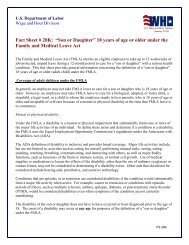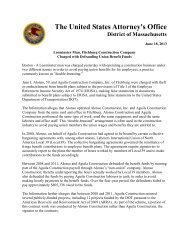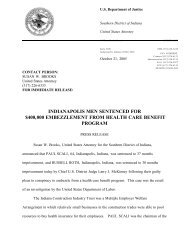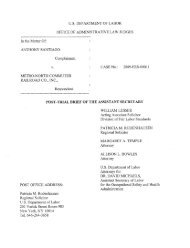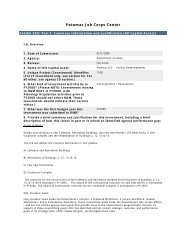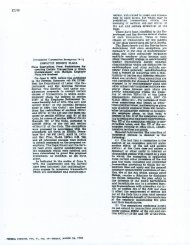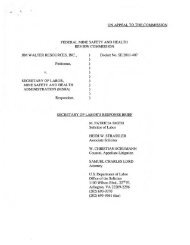Enthusiasm and Attitude
Enthusiasm and Attitude
Enthusiasm and Attitude
Create successful ePaper yourself
Turn your PDF publications into a flip-book with our unique Google optimized e-Paper software.
<strong>Enthusiasm</strong> <strong>and</strong> <strong>Attitude</strong><br />
What is the difference between “You’re hired!” <strong>and</strong> “Thank<br />
you for your interest, but…”? In a word: enthusiasm.<br />
<strong>Enthusiasm</strong> can mean the difference in not just getting a<br />
job, but succeeding in a job <strong>and</strong> even advancing in your<br />
career. A positive <strong>and</strong> enthusiastic attitude is a critical<br />
component of workplace success.<br />
Mastering Soft Skills for Workplace Success<br />
Having a positive attitude in the workplace<br />
can help with potential promotions.<br />
Employers promote employees who not<br />
only produce, but also motivate others<br />
in the workplace.<br />
When employers look at prospective c<strong>and</strong>idates, beyond skills, experience, <strong>and</strong> training, they look for<br />
those who demonstrate enthusiasm – those they believe will complete assigned tasks in an upbeat <strong>and</strong><br />
cooperative manner. All other things being equal, a c<strong>and</strong>idate who can demonstrate a positive attitude<br />
<strong>and</strong> eagerness to tackle the job will have an advantage over one who displays an attitude viewed by the<br />
employer as negative or disinterested. In fact, many employers would rather provide job skills training<br />
to an enthusiastic but inexperienced worker than hire someone with perfect qualifications but a lessthan-positive<br />
attitude. Managers sometimes worry that this type of person will not get along with<br />
supervisors <strong>and</strong> co-workers, treat customers disrespectfully, <strong>and</strong> not put much effort into his or her<br />
work. On the other h<strong>and</strong>, employees who are viewed as enthusiastic are known to provide good<br />
customer service, resolve interpersonal conflict effectively, <strong>and</strong> work productively with others.<br />
There are many ways in which an individual might demonstrate enthusiasm in the workplace. For<br />
example, in a job interview, he or she might smile, sit up straight, make eye contact, <strong>and</strong> discuss<br />
training <strong>and</strong> work experiences in an upbeat manner. Once hired into a position, an enthusiastic<br />
employee will typically show up on time, show interest in his or her job, <strong>and</strong> demonstrate a willingness<br />
to listen, learn, <strong>and</strong> try new things. In customer service settings, an enthusiastic employee will<br />
approach customers proactively <strong>and</strong> offer assistance or seek out tasks <strong>and</strong> projects when there is down<br />
time. This positive attitude helps employees go above <strong>and</strong> beyond to get along with co-workers <strong>and</strong><br />
managers – even difficult ones – <strong>and</strong> respond to constructive criticism with maturity <strong>and</strong> willingness to<br />
improve. Overall, an employee with enthusiasm comes across as someone who wants to be at work <strong>and</strong><br />
who is willing to do what it takes to get the job done.<br />
The activities in this section seek to teach participants about the importance of enthusiasm <strong>and</strong> a<br />
positive attitude in the workplace. Participants will hear strategies for turning negative thinking into<br />
positive thinking <strong>and</strong> displaying <strong>and</strong> discussing enthusiasm during an interview <strong>and</strong> on the job.<br />
Note to facilitators: A positive attitude is an “I can” attitude. Young people with real or perceived<br />
barriers to employment (such as those who struggle academically possibly due to a learning or other<br />
disability, have been in <strong>and</strong> out of foster homes, have dropped out of school, or are raising a baby) may<br />
not have experienced enough success to feel or demonstrate this attitude. The activities in this<br />
section offer an opportunity for you to help all youth learn how to develop a positive attitude <strong>and</strong>,<br />
almost as important, how to learn to showcase that to others, including employers. Regardless of the<br />
challenges young people have conquered, developing <strong>and</strong> displaying a positive attitude will often help<br />
them to surpass their peers in many aspects of life.<br />
35
Skills to Pay the Bills<br />
36<br />
6. Never Underestimate the Power of PMA<br />
JUST THE FACTS: PMA, or Positive Mental <strong>Attitude</strong>, is one’s ability to maintain the belief that he or she<br />
can transform or change a tough situation into something better. This activity will help participants take<br />
difficult situations <strong>and</strong> find ways to EMPOWER themselves to turn negative thinking into positive thinking.<br />
Time<br />
20 minutes<br />
Materials<br />
• One rolling die for each small group. Alternatively, you can use a “cut out” cube <strong>and</strong><br />
create it to look like a single dice, using either numbers one through six or the typical<br />
dots found on rolling dice. An easy cube shaped cut-out can be found at<br />
http://www.leslietryon.com/3dcolorcutout/cube.html<br />
• Optional: Chart paper/markers<br />
Directions<br />
Pose the following questions to participants. (This can be accomplished by group discussion<br />
or by smaller groups discussing together <strong>and</strong> then presenting to the larger group.)<br />
• What is a positive attitude? If I have a positive attitude, what actions might I display?<br />
What does a positive attitude “look” like to others?<br />
• What is a negative attitude? If I have a negative attitude, what actions might I display?<br />
What does a negative attitude “look” like to others?<br />
Then say: Developing a positive attitude starts from learning to believe in one’s self. In<br />
order to believe in ourselves, we must first underst<strong>and</strong> our personal strengths. In this<br />
activity, you will be considering <strong>and</strong> sharing your personal strengths.<br />
Break participants into groups of four. Write the below statements on a piece of chart paper<br />
for all to see, or have a “cheat sheet” at each table for reference. You might choose to create<br />
a chart <strong>and</strong> draw a picture of each roll of the dice (for those who learn best from pictures) on<br />
one side <strong>and</strong> write the corresponding statement on the other.<br />
Each participant will take turns rolling the dice two or three times <strong>and</strong> complete the<br />
following statement upon each roll:<br />
Roll a 1: I am thankful for…<br />
Roll a 2: Other people compliment me on my ability to…<br />
Roll a 3: Something I would like other people to know about me is…<br />
Roll a 4: I feel really good about myself when….<br />
Roll a 5: I am proud of my ability to…<br />
Roll a 6: Something nice I recently did for someone else was…
Mastering Soft Skills for Workplace Success<br />
NOTE: If the group knows each other well, feel free to substitute questions that ask about<br />
the positive qualities of their peers.<br />
Conclusion<br />
Ask participants why the statement for Roll #6 was included in this activity? Answers should<br />
be directed toward the fact that helping or “doing” for others often helps people feel good<br />
about themselves. And, when we feel good about ourselves, we often demonstrate a<br />
positive attitude that can be seen by others.<br />
Discuss with participants how internal feelings have the ability to impact those around us.<br />
How might a positive attitude help us on a job?<br />
Journaling Activity<br />
Do you think our attitude (whether positive or negative) is something we are born with or<br />
that we have power to control within ourselves? Think about a time when your attitude<br />
(either positive or negative) impacted you <strong>and</strong> those around you. When is it most<br />
challenging for you to keep a positive mental attitude? What do you do to help keep<br />
yourself positive during difficult times?<br />
Extension Activity<br />
Have participants keep a log for one week. Ask them to write down 50 (or 40 or 30) great<br />
things that happen each day. Encourage them to include even the small things like:<br />
someone held the door open for me….I found a quarter on the sidewalk…when I went<br />
shopping, the clerk at the store was really friendly <strong>and</strong> helpful. The goal of this activity<br />
is to have participants focus on the positive…<strong>and</strong> then discuss if they felt any different<br />
during the week as a result – either in their interactions with others or in their own<br />
feelings about themselves.<br />
37
Skills to Pay the Bills<br />
38<br />
7. Life is Full of Hard Knocks<br />
JUST THE FACTS: Failing is a part of life. In fact, it accounts for many, many successes – for without<br />
failing, success is almost impossible. Learning how to bounce back from failure is not always easy, but<br />
it is necessary. <strong>Enthusiasm</strong> for goal attainment is a necessary characteristic for success. This activity<br />
helps participants underst<strong>and</strong> that failure is not something to fear <strong>and</strong> in fact often a necessary step on<br />
the path to success.<br />
Time<br />
20 Minutes<br />
Materials<br />
• Activity 7a or 7b<br />
• Whiteboard or flip chart with markers or blackboard<br />
• Optional: Paper <strong>and</strong> colored pencils for drawing<br />
• Optional: Envelopes<br />
Directions<br />
Write the following statement large enough so all can see (<strong>and</strong> read aloud): THE ROAD TO<br />
SUCCESS IS PAVED WITH FAILURE.<br />
Divide the larger group into smaller groups. Ask each group to discuss the statement <strong>and</strong><br />
what they think it means. Alternatively, ask individual participants to draw a picture of<br />
what this statement means to them. Ask each group to share their feedback <strong>and</strong><br />
encourage other participants to comment or exp<strong>and</strong> on the responses.<br />
Decide whether you will use Activity 7a or 7b (Success or Failure), based on the make up<br />
of your group:<br />
• Option 1: Activity 7a was developed for discussion, though it could certainly be<br />
adapted to include a word bank or list of words from which to choose.<br />
• Option 2: Activity 7b provides materials that can be copied, cut out, <strong>and</strong> placed in<br />
separate envelopes to be used as an independent or small group matching exercise.<br />
• Option 3: Alternatively, you might choose to have 10 large pieces of paper placed<br />
around the room, each with one of the 10 descriptions written on it. Sentence strips<br />
or note cards could then have each of the 10 famous people written. Participants<br />
can take turns matching the famous person with their famous failure, <strong>and</strong>, thus, their<br />
eventual success.<br />
NOTE: Participants may benefit from having pictures of each of the famous people on<br />
the individual cards (along with the names). You can use an Internet search engine to<br />
find pictures of each famous person.
Conclusion<br />
Mastering Soft Skills for Workplace Success<br />
Discuss with participants different ways people might deal with failure. Pinpoint how<br />
people might deal with failure differently in different environments, such as at home, at<br />
school, or at work. Be certain to wrap up the activity in a positive way, focusing on the<br />
fact that without making mistakes, we would never succeed. Ask, “What do each of the<br />
people we discussed today have in common?” Answer: They refused to quit.<br />
Further discussion questions include: Would you have given up if you lost 8 elections?<br />
What if you wrote a book <strong>and</strong> 23 different publishers rejected it? What if just one<br />
publisher rejected it? What would you have done? What might the world be like today if<br />
Thomas Edison had given up?<br />
Journaling Activity<br />
Think of a time when you experienced a personal failure. What was the failure? How did<br />
this failure help you to become a better person, make better decisions, or succeed in a<br />
way you hadn’t imagined? Do you believe that failure is important? Why or why not?<br />
Extension Activity<br />
If you have Internet resources, check out some of the YouTube videos on “Famous<br />
Failures.” Simply type “famous failures” into the search bar to find results.<br />
Have students research additional “famous failures” <strong>and</strong> work in teams to create a<br />
YouTube video showcasing one of their own failures that ultimately had a positive effect.<br />
Another suggestion would be to use the information provided in this activity (famous<br />
people’s successes <strong>and</strong> failures) <strong>and</strong> have small groups work together to create a similar<br />
game or activity appropriate for younger children. This could then be shared with a local<br />
elementary school.<br />
39
Skills to Pay the Bills<br />
40<br />
CAN YOU NAME….<br />
Activity 7a. Success or Failure?<br />
1. …a famous person who was defeated seven times while running for political office?<br />
2. …a cartoonist who was told by the editor of the Kansas City newspaper, “It’s easy to see from<br />
these sketches that you have no talent.”<br />
3. …an author whose first children’s book was rejected by 23 different publishers?<br />
4. …a famous singer who was fired after his first performance at the Gr<strong>and</strong> Ole Opry?<br />
5. …a famous actress who dropped out of high school <strong>and</strong> held a variety of odd jobs, including<br />
doing the hair <strong>and</strong> make-up for corpses, before finally succeeding in show business?<br />
6. …a famous author who lived on welfare for years in an apartment infested with mice?<br />
7. …a famous athlete who was cut from the varsity basketball team his sophomore year in high<br />
school?<br />
8. …an inventor who was thrown out of school in the early grades because his teachers thought he<br />
couldn’t learn?<br />
9. …a famous Harvard University drop out?<br />
10. …an inventor of a fried chicken recipe that was rejected by more than 1000 restaurant owners?
ANSWERS:<br />
Mastering Soft Skills for Workplace Success<br />
1. Abraham Lincoln was defeated in eight different elections. Yet he persisted <strong>and</strong> succeeded in<br />
becoming the 16th, <strong>and</strong> one of the most respected, presidents of the United States.<br />
2. Walt Disney was told he had no talent <strong>and</strong> fired from a newspaper job. He wound up doing<br />
volunteer work for a church in an old run down garage. One day he decided to sketch one of<br />
the many mice that were running through the garage. This mouse became the famous<br />
“Mickey Mouse.”<br />
3. Twenty-three different publishers rejected Dr. Seuss’s first book, while the 24th accepted <strong>and</strong><br />
sold 6 million copies of it.<br />
4. Elvis Presley was fired after his first performance at the Gr<strong>and</strong> Ole Opry. The manager told<br />
him, “You ain’t going nowhere, son. You ought to go back to driving a truck.” He went on to<br />
become one of the most famous American singers of the 20th century.<br />
5. Whoopi Goldberg dropped out of high school, was on welfare <strong>and</strong> worked as a bricklayer,<br />
bank teller, <strong>and</strong> licensed cosmetician. After graduating from Beauty College, she took a job<br />
at a mortuary fixing the hair of <strong>and</strong> applying make-up to the corpses.<br />
6. J.K. Rowling, author of the Harry Potter series, lived on welfare for years, in an apartment<br />
infested with mice, <strong>and</strong> was rejected by 12 publishers before going on to fame <strong>and</strong> fortune.<br />
7. Michael Jordan was the athlete who was cut from the varsity basketball team in his<br />
sophomore year of high school. Angry <strong>and</strong> embarrassed, he began to get up early each<br />
morning to practice with the junior varsity coach. Eventually he not only made the varsity<br />
team, but also became one of the most popular athletes in the world. Michael Jordan is<br />
quoted as saying, “I have missed more than 9,000 shots in my career. I have lost almost 300<br />
games. On 26 occasions I have been entrusted to take the game winning shot, <strong>and</strong> I missed. I<br />
have failed over <strong>and</strong> over <strong>and</strong> over again in my life. And that is why I succeed.”<br />
8. Thomas Edison was the inventor who was kicked out of school. Following this, he was<br />
homeschooled by his mother. It took him over 700 tries before he got the filament right for<br />
the light bulb. Edison is quoted as saying: “I have not failed seven hundred times. I have not<br />
failed once. I have succeeded in proving that those seven hundred ways will not work. When I<br />
have eliminated the ways that will not work, I will find the way that will work.”<br />
9. Mark Zuckerberg dropped out of Harvard University. He went onto become the youngest<br />
millionaire (at the age of 26) <strong>and</strong> is the CEO of Facebook.<br />
10. Harl<strong>and</strong> David S<strong>and</strong>ers (better known as Colonel S<strong>and</strong>ers) had his fried chicken recipe<br />
rejected by more than 1,000 restaurant owners before it was accepted by one. Today, people<br />
still eat it at KFCs across the world.<br />
41
Skills to Pay the Bills<br />
42<br />
ABRAHAM LINCOLN<br />
( 16TH PRESIDENT OF THE UNITED STATES)<br />
DR. SEUSS<br />
(CHILDREN’S AUTHOR AND ILLUSTRATOR)<br />
WHOOPI GOLDBERG<br />
(FAMOUS ACTRESS)<br />
MICHAEL JORDAN<br />
(FAMOUS ATHLETE)<br />
MARK ZUCKERBERG<br />
(CEO OF FACEBOOK)<br />
Activity 7b. Success or Failure?<br />
WALT DISNEY<br />
(THE CREATOR OF MICKEY MOUSE)<br />
ELVIS PRESLEY<br />
(FAMOUS SINGER)<br />
J.K. ROWLING<br />
(WROTE THE HARRY POTTER SERIES)<br />
THOMAS EDISON<br />
(INVENTOR OF THE LIGHT BULB)<br />
COLONEL SANDERS<br />
(FOUNDER OF KFC)
LOST 8 ELECTIONS<br />
HAD A NERVOUS BREAKDOWN<br />
FIRST BOOK WAS REJECTED BY MORE THAN<br />
20 DIFFERENT PUBLISHERS<br />
DROPPED OUT OF HIGH SCHOOL AND<br />
PERFORMED ODD JOBS, SUCH AS FIXING THE<br />
HAIR AND MAKE UP OF CORPSES.<br />
WAS KICKED OFF OF HIS VARSITY<br />
BASKETBALL TEAM<br />
DROPPED OUT OF HARVARD UNIVERSITY<br />
Mastering Soft Skills for Workplace Success<br />
WAS TOLD HE HAD NO TALENT<br />
FOR DRAWING<br />
WAS TOLD TO GO BACK TO DRIVING A TRUCK<br />
AND QUIT SINGING<br />
LIVED ON WELFARE AND IN A HOUSE<br />
INFESTED WITH MICE<br />
REJECTED BY 12 DIFFERENT PUBLISHERS<br />
THROWN OUT OF SCHOOL BECAUSE HIS<br />
TEACHERS SAID HE COULDN’T LEARN<br />
HAD A RECIPE THAT WAS REJECTED FROM<br />
MORE THAN 1,000 RESTAURANTS<br />
43
Skills to Pay the Bills<br />
44<br />
8. A Super Ball <strong>and</strong> a Raw Egg<br />
JUST THE FACTS: One difference between people with a positive <strong>and</strong> enthusiastic attitude <strong>and</strong> people<br />
with a negative attitude is that the former look at failure as an opportunity to try again. This activity<br />
offers an opportunity to use everyday objects to demonstrate this valuable outlook.<br />
Time<br />
20 minutes<br />
Materials<br />
• One super ball (hard rubbery ball that bounces high)<br />
• Three raw eggs (or one for each participant) If you would rather not use raw eggs,<br />
small, thin water balloons are just as effective<br />
• Large sheet, drop cloth, or newspaper<br />
• Masking tape<br />
It is suggested that facilitators complete Activity 7 (Success or Failure) prior to completing<br />
this activity.<br />
Directions<br />
Tape a large sheet, drop cloth, or piece of newspaper to the wall; put another on the floor<br />
directly underneath to catch the broken egg. Draw a set of concentric circles on the sheet,<br />
drop cloth, or piece of newspaper on the wall, making a target. (Another option is to simply<br />
put the target on the floor <strong>and</strong> have participants drop each object from above.)<br />
Without explaining the point of the illustration, ask for six volunteers. The first three take<br />
the super ball <strong>and</strong> throw it at the target, trying to get the closest to the center. The second<br />
three throw the raw eggs.<br />
Say something to the effect of: When this super ball was thrown against the wall, what<br />
happened? [It bounces back.] What happens the harder it is thrown? [The faster it<br />
bounces back.]<br />
What happened to the raw egg when it was thrown against the wall? [It splattered.] What<br />
happens the harder it is thrown? [The worse it splatters…or the bigger the mess.]<br />
These objects define two very different types of people: raw egg people <strong>and</strong> super ball<br />
people. When raw egg people hit a “bump in the road,” they splatter. The harder they hit,<br />
the harder they splatter, usually giving up on their goal. When super ball people hit an<br />
obstacle, they bounce back. The more difficult the obstacle, the harder they bounce back.
Mastering Soft Skills for Workplace Success<br />
If Activity 7 was used previously: The people we just talked about when we talked<br />
about Successes or Failures were ALL super ball people. With every failure they<br />
experienced, they kept bouncing back.<br />
If Activity 7 was not used, simply ask: Why do you think people bounce back after<br />
failing at something. What are some of the things you learn when you fail? Who do<br />
you know (either a famous person or someone you know personally) that has bounced<br />
back from failure to become really successful?<br />
Conclusion<br />
In a small group, discuss what makes people bounce back from defeat? (Allow a few<br />
minutes for thought, reflection, <strong>and</strong> discussion.)<br />
Journaling Activity<br />
Think about a time when you wanted to give up on something but didn’t. What was the<br />
situation? Why did you want to give up? Why didn’t you? How did you deal with it?<br />
Extension Activity<br />
Have participants describe what success means to them. Methods of expression might<br />
include writing a poem, a dance, drawing a picture, creating a song or a rap, creating a<br />
collage from magazine pictures, configuring a word cloud, etc. Allow participants to<br />
express themselves in a way they feel most comfortable.<br />
45
Skills to Pay the Bills<br />
46<br />
9. Believe It or Not: Your <strong>Attitude</strong> <strong>and</strong> <strong>Enthusiasm</strong><br />
Just Might Get You the Job<br />
JUST THE FACTS: According to many sources, the enthusiasm you display on a job interview can make<br />
the difference between getting the job <strong>and</strong> not getting the job. Some even say that attitude can<br />
account for up more than 40% of your rating! This activity will focus on the different attitudes that can<br />
be (<strong>and</strong> have been) displayed during a job interview. In a job interview, enthusiasm comes across as<br />
showing a genuine interest in the job.<br />
Time<br />
30 - 40 minutes<br />
Materials<br />
• Activity 9<br />
• Y ou will need three actors/actresses. One will play the interviewer, one will play the<br />
positive job applicant, <strong>and</strong> one will play the not-so-positive job applicant<br />
• If possible, the not-so-positive job applicant could use props such as a cell phone,<br />
chewing gum, boxer shorts showing, <strong>and</strong> anything else that might be perceived as<br />
unprofessional<br />
Note: You may choose not to use the role-play scripts – <strong>and</strong> instead have participants<br />
answer the questions in their own way — underst<strong>and</strong>ing that one person interviews very<br />
well, while the other doesn’t (to the extreme). This is a good strategy for non-readers or<br />
those with limited reading proficiency.<br />
Directions<br />
Ask participants: Did you know that often an employer will decide within the first 30<br />
seconds if an applicant is right for the job?<br />
What do you think can come across in 30 seconds? Why is the first 30 seconds so important?<br />
Elicit responses. Obviously, this means you need to be on top of your game going into the<br />
interview.<br />
Ask for volunteers to read a role play script about job interviews. Allow volunteer actors/<br />
actresses a few minutes to review the scripts. Explain to each “interviewee” that they<br />
should be “over the top” <strong>and</strong> that the “good” interviewee should be really, really good;<br />
<strong>and</strong> the “bad” interviewer should be really, really bad.
Conclusion<br />
Mastering Soft Skills for Workplace Success<br />
Discuss with participants the fact that these examples are both ends of the extreme. What<br />
are some of the takeaways from either observing or participating in this role play?<br />
Depending on how the interviewees “acted,” there is a good chance that both interviewees<br />
demonstrated enthusiasm – <strong>and</strong> even if it wasn’t “spoken,” interviewee #2 certainly was<br />
excited about his/her tattoos <strong>and</strong> ability to eat rocky road ice cream. Talk about the<br />
difference between both types of enthusiasm.<br />
Participants may wish to act out another interview scenario (with or without the script), if<br />
time allows.<br />
Journaling Activity<br />
You have a friend who is getting ready for a job interview. This friend is not feeling too<br />
positive lately, <strong>and</strong> you want to help her get ready for this interview. What are some things<br />
you might do to help your friend prepare?<br />
Extension Activity<br />
Divide the larger group into smaller groups of three or four. Instruct each group to write<br />
another role play demonstrating positive attitude <strong>and</strong> “focused” enthusiasm. This role play<br />
can focus, again, on an interview, or can be an example of a situation that might happen<br />
on-the-job. Each group should have the opportunity to act out their role play.<br />
47
Skills to Pay the Bills<br />
48<br />
INTERVIEWER’S SCRIPT<br />
Activity 9. Interview Role Play<br />
“Good morning, my name is [Mr. or Ms.] _______________________ <strong>and</strong> I will be conducting your<br />
interview this morning.” Extend your h<strong>and</strong> to shake h<strong>and</strong>s with the applicant. “Please have a seat.”<br />
“We are interviewing for the position of a restaurant host/hostess. We are looking for someone with<br />
good customer service <strong>and</strong> communication skills, someone who is dependable <strong>and</strong> gets along with<br />
others. This person will be the first person to greet guests when they come into our restaurant, so it is<br />
very important to us that the host displays a positive <strong>and</strong> welcoming attitude.”<br />
“Now, I have some questions to ask you.”<br />
“Did you bring a copy of your resume?”<br />
“Tell me a little bit about yourself.”<br />
“What are your strengths?”<br />
“What are your weaknesses?”<br />
“Why do you want to work here?”<br />
“Tell me about a recent job or volunteer position you had.”<br />
“Why did you leave that position?”<br />
“Do you have any questions for me?”
Activity 9. Interview Role Play<br />
Mastering Soft Skills for Workplace Success<br />
INTERVIEWEE SCRIPT 1<br />
Q: “Did you bring a copy of your resume?”<br />
Yes, sir (or ma’am), I did. [You open up a folder you brought with you to the interview (where you<br />
have copies of your resume). You h<strong>and</strong> one copy to the interviewer.]<br />
Q: “Tell me a little bit about yourself.”<br />
I have lived in [your city or state] all of my life, I love being around people, <strong>and</strong> I love learning new<br />
things. Right now, I’m learning a new language because I think it is important to be able to<br />
communicate with a variety of people. I also like doing physical work <strong>and</strong> enjoy gardening <strong>and</strong><br />
l<strong>and</strong>scaping. I’m quite proud of my yard.<br />
Q: “What are your strengths?”<br />
I’m a really good listener. Don’t get me wrong, I’m a good talker too, but I think listening skills are<br />
even more important. I’m also a good organizer. It doesn’t make any difference if it is organizing my<br />
closet or a trip with my family; I love all the planning <strong>and</strong> organizing that goes into it.<br />
Q: “What are your weaknesses?”<br />
I like things to go according to my plans so when something comes up that may make my plans go off<br />
schedule it sometimes stresses me out. But what I have learned about myself is that coming up with<br />
a plan B helps a lot! So, if I plan ahead for potential problems, then I don’t stress out at all because<br />
I have a good idea of what to do next.<br />
Q: “Why do you want to work here?”<br />
As I said earlier, I love being around people <strong>and</strong> in this job I’d get to meet every person that walks<br />
through the door. Your restaurant has a good reputation for quality food <strong>and</strong> service <strong>and</strong> that’s the<br />
type of restaurant I’d be proud to work in. I think my qualities will fit nicely here.<br />
49
Skills to Pay the Bills<br />
50<br />
Q: “Tell me about a recent job or volunteer position you had.”<br />
I worked in a cafeteria serving food. Sometimes I worked in the kitchen but I really loved working as a<br />
server. I got to meet a lot of people. Some days were easier than others. I set a goal for myself to smile<br />
at everyone I served, especially those people who seemed upset or depressed. It may seem like a<br />
boring job to some people but not me.<br />
Q: “Why did you leave that position?”<br />
I left because I had started school <strong>and</strong> couldn’t do both school <strong>and</strong> work at the same time.<br />
Q: “Do you have any questions for me?”<br />
Your staff has a great reputation for customer service, so I thought perhaps I’d ask if you have a<br />
training program you put your staff through to achieve that?<br />
Before you leave:<br />
I also have a list of references for you. [H<strong>and</strong> the interviewer a sheet of paper.] Thank you for the<br />
interview; it was a pleasure to meet you. [Offer a professional, firm h<strong>and</strong>shake – <strong>and</strong> a smile.]
Activity 9. Interview Role Play<br />
Mastering Soft Skills for Workplace Success<br />
INTERVIEWEE SCRIPT 2<br />
This version of the interview should be over-the-top “bad.” The c<strong>and</strong>idate should be dressed<br />
inappropriately, wearing sunglasses, chewing gum, displaying poor posture, disorganized, late, etc.<br />
In fact, the interviewee doesn’t pay attention when the interviewer begins – <strong>and</strong> doesn’t realize that<br />
the interviewer offered to shake h<strong>and</strong>s because he/she was too busy putting a cell phone in his/her<br />
pocket.<br />
Q: “Did you bring a copy of your resume?”<br />
A resume? Oh, yeah…it’s in here somewhere. [Dig around in your pocket or bag until you find a crumpled<br />
resume. Smooth out the paper <strong>and</strong> h<strong>and</strong> it to the interviewer.]<br />
Q: “Tell me a little bit about yourself.”<br />
Well, I’ve been taking a little time off lately – traveling around the United States. I’m trying to get one<br />
tattoo from every state. I’ve already got a pretty good start, see? [Show the interviewer your bare arm.]<br />
Q: “What are your strengths?”<br />
I can talk to anybody…<strong>and</strong> about any subject! There’s never a dull moment when I’m in a room.<br />
Q: “What are your weaknesses?”<br />
Hmmm, I can’t think of anything. Oh yeah, I have a weakness for Rocky Road ice cream. I bet I could eat<br />
an entire gallon in one sitting. I also like to sleep late. Really, I’m much more of a night owl than an<br />
early bird. Sure the early bird gets the worm, but who wants worms anyway?<br />
Q: “Why do you want to work here?”<br />
I figured I’d be able to get free meals if I worked for a restaurant. Plus, I’m living at home with my<br />
mom <strong>and</strong> she wants me to pay rent…why, I don’t know.<br />
51
Skills to Pay the Bills<br />
52<br />
Q: “Tell me about a recent job or volunteer position you had.”<br />
Uh, the last job I had was at a sporting goods store. That was a while ago, though – <strong>and</strong> it didn’t last<br />
too long.<br />
Q: “Why did you leave that position?”<br />
Well, me <strong>and</strong> the manager didn’t always see eye to eye. Sometimes customers were pretty rude<br />
when we didn’t have the sports equipment they wanted <strong>and</strong> my manager expected me to be nice to<br />
these people when they clearly didn’t deserve it. Let’s just say I left by mutual agreement.<br />
Q: “Do you have any questions for me?”<br />
Do your employees get free meals?
10. Translating Features to Benefits<br />
Mastering Soft Skills for Workplace Success<br />
JUST THE FACTS: Marketing executives translate features to benefits when they are preparing to sell<br />
products <strong>and</strong> services. For example, your cell phone plan offers call forwarding (a feature). This<br />
means you will never miss another important call (a benefit). In another example, the new car you<br />
want to buy has a built-in GPS system (feature). The salesperson probably tells you that with built-in<br />
GPS you will never get lost or need to print out Internet directions again (benefit). The purpose of this<br />
activity is to help participants list <strong>and</strong> explain the positive personality traits (or personal features) they<br />
possess <strong>and</strong> how to communicate those traits to an employer. Remember: Features tell…benefits sell.<br />
Time<br />
30 minutes<br />
Materials<br />
• Chart paper, white board (or anything on which to write so a large group can see),<br />
<strong>and</strong> markers<br />
• Three to five notecards per participant<br />
Directions<br />
Write the following statistics on a flip chart or white board:<br />
40% - <strong>Attitude</strong><br />
25% - Image <strong>and</strong> appearance<br />
25% - Communication skills (verbal <strong>and</strong> non-verbal)<br />
10% - Job skills<br />
According to a variety of sources, your attitude is the #1 factor in getting or losing a job. On<br />
the chart is how it is often broken down. Take a few minutes to discuss what each of these<br />
"looks like.” For example:<br />
• <strong>Attitude</strong>: Do you demonstrate confidence <strong>and</strong> enthusiasm, are you on time or early?<br />
• Image <strong>and</strong> appearance: Do you wear too much perfume or cologne, are your clothes<br />
wrinkled or inappropriate for the work environment?<br />
• Communication skills: Do you look the interviewer in the eye, is your h<strong>and</strong>shake firm,<br />
do you speak clearly?<br />
Ask participants (<strong>and</strong> discuss) why they think attitude is rated highest? How does an<br />
employer get a sense of your “attitude” during an interview?<br />
Explain that part of a job interview is actually a sales job. You are “selling” yourself <strong>and</strong><br />
your skills to an employer. This is not an easy task for many of us because we may not be<br />
sure about our skills, lack a bit of self-confidence, or are just plain nervous. This is one<br />
skill that will definitely get better the more it is practiced.<br />
53
Skills to Pay the Bills<br />
54<br />
In order to begin thinking about how we might “sell” ourselves in a job interview,<br />
participants will learn how to turn their personal FEATURES into BENEFITS for the employer.<br />
This is where they will be able to tell an employer what they have to offer while also giving<br />
the employer a reason why this feature is good for his or her business.<br />
Take a few minutes to brainstorm some positive personality traits. Ask participants to<br />
“yell” them out while you write them where all can see. Examples of positive personality<br />
traits include, but are certainly not limited to: friendly, creative, honest, dependable,<br />
trustworthy, enthusiastic, upbeat, patient, polite, helpful, etc.<br />
Now, ask participants to think about what these features might mean to an employer. For<br />
example:<br />
• Honesty (feature) means you can be counted on to do the right thing (benefit).<br />
• Friendliness (feature) means you will help customers feel welcomed (benefit)<br />
Review a few of these examples until participants feel comfortable with the activity.<br />
Give each participant a set of notecards. On one side of the card participants should draw<br />
a picture of or write a FEATURE they possess. On the other side of the card, they should<br />
draw a picture of or write the BENEFIT (or why this feature would be important) to the<br />
employer. Depending on the group, this activity can be done individually or in groups of<br />
two or more.<br />
Once complete, ask for volunteers to read their personal traits <strong>and</strong> how they might benefit<br />
a future employer. Alternatively, you can ask participants to act out their FEATURES <strong>and</strong><br />
see if the group can guess both the FEATURE <strong>and</strong> the BENEFIT to an employer.<br />
Conclusion<br />
Discuss with participants the ease or difficulty they experienced with this activity. In<br />
addition, discuss some examples of different features that may be perceived as<br />
“challenging” <strong>and</strong> how they may be described positively as benefits. For example:<br />
• “Over the years, I’ve learned what it means to multi-task.” (someone who has ADD)<br />
• “I am a great problem solver. You should see some of the places I’ve needed to get<br />
into!” (someone who uses a wheelchair)<br />
Journaling Activity<br />
Describe how it makes you feel talking about yourself in a positive way. Is it easy, difficult,<br />
awkward, etc.? Since this is important when it comes time getting a job, what might you<br />
do to improve your ability to do this? If this is already easy for you, how can you be sure<br />
you don’t come across as “full of yourself” or conceited?
Extension Activity<br />
Mastering Soft Skills for Workplace Success<br />
Have participants use their individual Features to Benefits cards to create a “30-Second<br />
Commercial.” Explain that their goal is to hook an employer on hiring them, just as they<br />
might get hooked on buying something from TV after seeing a commercial for the product.<br />
A few suggestions for this activity include: record participants, allow for multiple takes<br />
<strong>and</strong> retakes, encourage feedback <strong>and</strong> suggestions from peers, etc. Encourage participants<br />
to view each of their successive videotapes to look for improvement.<br />
You may also wish to invite one or more employers in to critique each commercial <strong>and</strong><br />
provide feedback <strong>and</strong> suggestions. Only bring employers into the mix once participants<br />
have had the opportunity to practice <strong>and</strong> feel a bit more confident “selling” themselves.<br />
55







